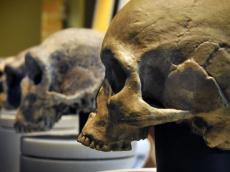|
|
TODAY.AZ / World news
Recent archaeological discovery in Germany rewrites Homo Sapiens' history
01 February 2024 [20:15] - TODAY.AZ

By Alimat Aliyeva
Fragments of human bones found in a cave in central Germany show that modern humans — Homo sapiens — arrived in the cold highlands of Europe 47,500 years ago. Scientists have suggested that this date was 40 thousand years before the new discovery, Azernews reports, citing the journal Nature.
On Wednesday scientists reported that they had discovered the skeletal remains of 13 Homo sapiens in the Ilsenhele cave, located under the medieval settlement in Ranis in Germany. It was found that the bones were 47,500 years old. The oldest remains of Homo sapiens discovered so far in North-Central and North-Western Europe are about 40,000 years old.
Jean-Jacques Hublain, a paleoanthropologist and head of research at the Collège de France in Paris, said that the date of these fragments was determined directly using radiocarbon dating. According to him, well-preserved Homo sapiens DNA was also obtained.
The species Homo sapiens originated in Africa more than 300,000 years ago, then spread around the world and encountered other human populations, including Neanderthals. However, the fragmented fossil record does not explain in detail how Homo sapiens spread across Europe and what role it played in the extinction of the Neanderthals, who disappeared about 40,000 years ago.
The study, presented in three articles published in the journal Nature, sheds light on a new process of ecology and evolution of nature. It turns out that at that time it was colder on the continent than it is now, and frosts prevailed in Europe, which are now in Siberia or Scandinavia – in the desert tundra. Homo sapiens, despite its origin from warmer Africa, was able to adapt relatively quickly to colder conditions.
The researchers concluded that small mobile groups of hunter-gatherer tribes used the cave from time to time, wandering through an area full of Ice Age mammals.
The study also resolved the dispute over who produced one or another set of European stone artifacts belonging to the Lincombe-Ranis-Erzmanovica culture (LRJ), including stone blades in the shape of leaves that could be used as spear tips for hunting. Previously, experts assumed that they belonged to Neanderthals. But it turned out that these ancient objects were made by Homo sapiens.
The scientists analyzed the bones based on mitochondrial DNA, reflecting maternal heredity. Research continues using nuclear DNA, which provides genetic information from both parents, including the mixing of Homo sapiens with Neanderthals in Ranis.
URL: http://www.today.az/news/regions/244251.html
 Print version
Print version
Connect with us. Get latest news and updates.
See Also
- 29 July 2025 [09:00]
China to offer childcare subsidies in bid to boost birth rate - 28 July 2025 [22:21]
Thales Alenia Space and Italy to develop first lunar base - 28 July 2025 [21:50]
Filming starts soon for the long-awaited Shrek sequel - 28 July 2025 [21:22]
Rare 4,000-year-old Egyptian handprint find in England - 28 July 2025 [20:50]
Alibaba to launch AI glasses to compete with Meta - 28 July 2025 [19:45]
Telegram launches official age verification bot - 28 July 2025 [09:00]
Liverpool pays tribute to late striker Diogo Jota during friendly match against Milan - 28 July 2025 [08:00]
EU airports set to scrap 100ml liquid rule with new screening tech - 27 July 2025 [22:10]
Arsenal FC signs new football player - 27 July 2025 [14:10]
Cambodian, Thai leaders agree to ceasefire talks amid ongoing armed conflict, says US President
Most Popular
 Azerbaijan ready to facilitate Kyiv-Moscow dialogue in Baku
Azerbaijan ready to facilitate Kyiv-Moscow dialogue in Baku
 UN General Assembly adopts AI resolution initiated by Tajikistan
UN General Assembly adopts AI resolution initiated by Tajikistan
 Thailand expands military operations into Cambodia, says Cambodian Defense Ministry
Thailand expands military operations into Cambodia, says Cambodian Defense Ministry
 Azerbaijani official addresses US involvement rumors in Zangezur Corridor
Azerbaijani official addresses US involvement rumors in Zangezur Corridor
 Speaker of Azerbaijani Parliament departed for business trip to Geneva
Speaker of Azerbaijani Parliament departed for business trip to Geneva
 Arsenal FC signs new football player
Arsenal FC signs new football player
 Donald Trump confirms upcoming meeting with EU Commission President in Scotland
Donald Trump confirms upcoming meeting with EU Commission President in Scotland
